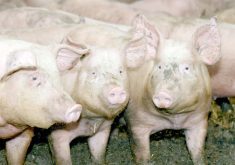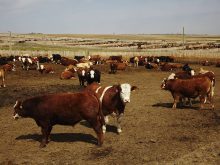RED DEER – Manure is an important way to add nutrients to cropland, but
it should not be used like an “off-the shelf fertilizer,” says a
University of Saskatchewan researcher.
Jeff Schoenau told the Farm Tech 2002 conference in Red Deer manure is
good for soil and crops because it helps balance plant nutrition and
soil fertility. It also adds tilth and increases crop yields.
However, manure does not always have the right balance of nutrients,
depending on the species of animal and whether it is in the solid,
Read Also

Lending policy still focused on primary producers: Farm Credit Canada
Farm Credit Canada said it has not changed its business practices and remains committed to supporting all producers, after a report from an Ottawa-based media outlet claimed otherwise.
semi-solid or liquid form.
Schoenau said it is important to know the nutrient components found in
each manure sample. It is also important to be able to predict the
variability of nutrients such as nitrogen, phosphorus, potassium,
sulfur and micronutrients.
“It is not an off-the-shelf fertilizer. Manure is complex and
variable,” he said.
Liquid swine manure is 98 percent water and two percent solid.
It provides an almost immediate release of nutrients to plants, with 25
percent of liquid manure’s nitrogen being available to plants in the
first year. However, its beneficial effects wear off within a couple of
years.
Liquid manure may also be low in sulfur and may not have enough
phosphorus in relation to nitrogen.
In Saskatchewan and Alberta’s Peace River district, farmers adding
swine manure to canola fields reported good crops, but Schoenau said
they might find they need to provide additional elemental sulfur.
Solid cattle manure builds the soil over a longer period. Nitrogen is
slowly released and adds organic matter. Fresh manure out of the pen
may not release much nitrogen in the first year, but the benefit is
more obvious in subsequent years.
Solid manure releases nitrogen at variable rates and its benefits
linger for three to four years.
Cattle manure may have high levels of phosphorus in relation to the
nitrogen content, as well as a high level of carbon derived from straw
or wood chips in the mix.
It can be difficult to spread solid manure uniformly.
As well, too much manure can have serious implications.
Manure contains lots of salt, which may hurt plant germination. Too
many applications may result in ammonium toxicity. Manure stimulates
green growth, so cereals could have lodging problems.
“When manures are managed correctly, they are very effective crop
amendments,” Schoenau said.
“Balance the rate with crop demand. If you over apply manure, you can
get into trouble both environmentally and agronomically,” he said.
“Placement is so important. Get it in the ground.”
Studies show if swine manure is injected eight to 10 centimetres deep
in bands, plants are able to recover 43 percent of nutrients almost
immediately.
Broadcast manure showed 31 percent plant uptake.
Injecting manure also reduces odour.
Manure is too bulky to haul long distances. Composting is widely
accepted in Alberta and is proving to be an effective soil amendment,
with fewer pathogens and reduced odour.















